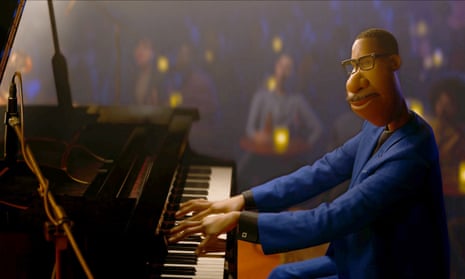This typically ambitious Pixar animation comes on like a fever-dream cross between Disney’s Fantasia and Powell and Pressburger’s A Matter of Life and Death, with a bizarre hint of Peter Jackson’s The Lovely Bones thrown in for good measure. A tale of a music teacher who loses his life but discovers his soul, it’s a visually sumptuous riot of ideas, pitched somewhere between a playful musical, a divine comedy and a metaphysical drama.
Just as the Minions movie opened to the delightful helium sounds of its heroes happily “ba-ba-BA”-ing the famous Universal theme, so Soul begins with the distinctive Disney anthem being jazzily murdered by a discordant school band. If music teacher Joe Gardner (Jamie Foxx) could wish upon a star, he’d wish to be somewhere else, preferably tinkling the ivories at a swinging club. Joe’s dream comes true when he gets a late-in-the-day call asking him to sit in with hip jazz saxophonist Dorothea Williams (Angela Bassett). The audition goes well – so well, in fact, that Joe leaves with his head in the clouds and promptly falls to his death down an open manhole.
So far, so slapstick. Yet finding himself on a moving stairway to the Great Beyond, and determined not to miss the chance of a lifetime, Joe runs the other way and winds up in the Great Before, a dreamy neverland where protean souls are assigned “unique and individual personalities” before being sent to Earth. Here, he meets 22 (Tina Fey), who has refused to take her place in the real world despite the best efforts of a string of teachers, including Gandhi, Lincoln and Mother Teresa (“I made her cry”). And thus it falls to the disembodied Joe to help 22 find her spark, with unexpected body-swapping results.
Co-written and directed by Pete Docter, Soul shares many of the traits of his previous outings, Up and Inside Out. Like the latter, it addresses existential issues (the construction of personality; nature v nurture) through the accessible language of animation – like a theologically fired revisiting of the strip cartoon The Numskulls. And like Up, in which an old man rediscovers the meaning of life after turning his house into a helium balloon-powered airship, it ties its redemptive message to a bizarrely convoluted plot that occasionally trips over its own narrative shoelaces.
It’s easy to become blase about the visual brilliance, both technical and artistic, of Pixar’s output, but Soul really is a treat for the eyes. From the almost photo-realist clarity of the earthbound scenes (the jazz club interiors give Damien Chazelle’s work on The Eddy a run for its money) to the otherworldly eeriness of the out-of-body segments, it’s a pleasure to watch. Witness the tangible physical beauty of Joe’s fingers flitting across the keyboards as music transports him to another dimension, juxtaposed with the wonderful strangeness of creatures from another world that resemble trippy line drawings of Fred Flintstone as reimagined by Picasso.
With an original score by Trent Reznor and Atticus Ross, and jazz compositions and arrangements by Jon Batiste (the ambassadorial house-band leader for Stephen Colbert’s The Late Show), Soul has musical pizzazz to spare. Foxx, who won an Oscar playing Ray Charles, lends emotional depth to Pixar’s first African American leading role, with co-director/writer Kemp Powers (along with consultants such as anthropologist Dr Johnnetta Cole) ensuring that the film’s cultural reference points strike just the right note.
